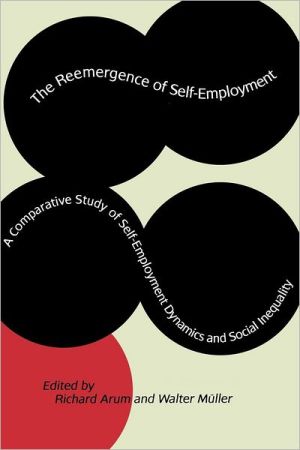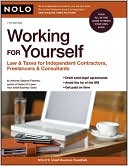The Reemergence of Self-Employment: A Comparative Study of Self-Employment Dynamics and Social Inequality
This book presents results of a cross-national research project on self-employment in eleven advanced economies and demonstrates how and why the practice is reemerging in modern societies. While traditional forms of self-employment, such as skilled crafts work and shop keeping, are in decline, they are being replaced by self-employment in both professional and unskilled occupations. Differences in self-employment across societies depend on the extent to which labor markets are regulated and...
Search in google:
"Inspired and impressive. This will become the standard work on its topic."--John Goldthorpe, Nuffield College, Oxford University
The Reemergence of Self-Employment\ A Comparative Study of Self-Employment Dynamics and Social Inequality \ \ By Richard Arum and Walter Müller \ Princeton University Press\ Richard Arum and Walter Müller\ All right reserved.\ ISBN: 0691117578 \ \ \ Chapter One\ SELF-EMPLOYMENT DYNAMICS IN ADVANCED ECONOMIES\ Walter Müller and Richard Arum\ IN THE SECOND half of the twentieth century, social scientists typically viewed self-employment as an obsolete remnant of past forms of economic organization: its small-scale mode of production was expected to disappear under the dominating logic and competitive pressures of capital accumulation and mass production. Contrary to such predictions, recent developments have demonstrated that self-employment has resisted these pressures. Rather than diminishing its role in contemporary advanced societies, self-employment has grown in many national settings over recent decades. However, recent economic and social changes have not only reinvigorated self-employment, but also affected its character. Both developments require that social stratification researchers rethink their assumptions and reconceptualize their approach toward examining this activity.\ Even if self-employment has merely persisted, it still represents a highly particular way to gain one's living in modern economic contexts. For most advanced societies, indeed, a cross-sectional picture immediately demonstrates that the self-employed constitute only a small fraction of the labor force. At any given time, only a minority fail to follow the normative practice of selling their labor capacity to an employer, but rather use their human, social, and economic capital for a business of their own and at their own risk. The first basic question then still is: What are the factors leading individuals into self-employment and then inducing them to remain active in these kinds of endeavors?\ A self-employment rate of about 10 percent of the nonagricultural labor force is typically found in most advanced societies. However, in some societies this rate is much higher, in particular in the south of Europe and in Asian countries. In these countries, the rate of self-employment may be more than double the usual size, and in some national settings it accounts for 25 to 30 percent of the labor force. In earlier decades the high cross-national variation in the share of self-employment often was attributed to delays in economic development with convergence expected in the course of modernization. Today such explanations have lost much of their plausibility as even in economically highly advanced countries, such as Italy or Japan, self-employment has remained at very high levels. One should expect that societies with these widely varying levels of self-employment also vary in other ways, such as in the organization of work or even more generally in principles of social organization. How, then, can we account for the continued strong variation between countries in the presence of self-employment today? What are the implications of different economic and social contexts for the level and character of self-employment?\ In the past, sociologists often assumed that self-employment to a large extent could be equated with the petty bourgeoisie, considered as a particular social class with its own specific social basis and principles of class formation and reproduction. Even though it has been characterized as the "uneasy stratum" (Bechhofer and Elliott 1981) and its internal heterogeneity has been widely acknowledged, it was assumed that this class mainly consisted of small proprietors, shopowners, skilled craftspeople, nonprofessional service providers, and others with similar working conditions who were running their own business. The bulk of the self-employed did indeed belong traditionally to these groups. Besides not working for wages or salaries, they shared a number of further common characteristics, notably a high level of intergenerational inheritance, a particular "moral economy" (Bechhofer and Elliott 1981:189), and specific political attitudes and orientations. Significant changes in the technology of production and the economic opportunity structure have recently occurred in many countries, including a revolution in computing and new communication technologies; expansion of female employment; the growth and persistence of mass unemployment; the decline in goods-producing industries and concentration of the distribution of goods in larger units; the rise of the service sector and increased professionalization; the growth of flexible production; and the spread of nontraditional work arrangements. For all these developments, arguments have been advanced that have repercussions on self-employment. What has been the impact of economic change on the character of self-employment, the composition of the group, its internal homogeneity, and its economic strength and stability?\ Self-employment and small firm production have always constituted a context of work very different from employment in large, bureaucratically organized private companies or public administration. Specific social relations have usually been involved in the traditional petty bourgeois work unit: "The 'boss' works alongside his 'labour force.' Often the 'labour' is recruited from the networks of kinship, friendship and neighbourhood and thus there are 'non-contractual' elements in the relationship from the start." These authors also suggest that "in a society where large impersonal institutions mould much day-to-day living, this personalising of work relationships may be welcomed by both sides" (Bechhofer and Elliott 1981:194). Perhaps most significant in this traditional small-scale economic form of organization, and rather distinct in the modern context in which work tends to be separated and isolated from the family, has been the often intimate union of family and work in the self-employed venture. Indeed, self-employment has often been a family business, strongly dependent on the work of a married couple and their children. Women today, however, are more inclined to pursue their own independent careers and projects-even though to a varying extent in different societies-and children are certainly no longer easily kept as cheap family labor. Has thus the family-embeddedness of self-employment eroded? Has the separation between spheres of life also invaded self-employment and transformed its social character? Is the varying extent to which individuals in different societies have access to family resources precisely one of the factors that lies behind the uneven level and character of self-employed activity?\ In research on social stratification, the family relatedness of self-employment has been particularly studied in the view of intergenerational inheritance of self-employment. It is regularly found that entry into self-employment is often a matter of directly inheriting a parental business, particularly so in agricultural self-employment where the family farm is passed from generation to generation. Also in this sense, self-employment has been characterized as a remnant of a social order, in which the intergenerational reproduction of social inequality still occurs primarily via direct inheritance, in contrast to access to positions of dependent work, where the transmission of advantage from generation to generation occurs mainly through socially unequal participation in education. Is contemporary self-employment still characterized by the traditional mode of socially inherited reproduction, or have more recent forms of self-employment moved in a direction whereby acquired human capital resources have gained a significant role compared with both transmission of material capital and the provision of social capital?\ These are some of the core substantive questions that we pursue in this book with eleven national case studies on entry into and survival in self-employment. The national case studies provide both rich historical and contextual information to understand the specific nature of self-employment and the conditions of its recent development. The book concludes with a chapter presenting a comparative meta-analysis of cross-national results.\ In this introductory chapter, we provide background information essential to understanding the topic, advance a theoretical framework for a cross-national study of self-employment dynamics, discuss the research design for the analysis, and present an outline of the structure of the book. In particular, we will discuss the reemergence of self-employment; the extent to which renewed analysis of self-employment is critical to understanding social inequality; the contemporary historical context of changes in work and employment relationships that have affected self-employment characteristics; a theoretical framework that emphasizes how resources, opportunities, and constraints structure individual-level decision making related to self-employment dynamics; and relevant dimensions of institutional and societal cross-national variation that affects self-employment outcomes.\ SELF-EMPLOYMENT'S REEMERGENCE\ Self-employment can no longer be dismissed as an economic activity on the verge of withering away in response to processes of capital accumulation or through competition with large firms. In the last quarter of the twentieth century, nonagricultural self-employment in most advanced economies reversed a historic pattern of decline and significantly increased its relative economic presence. In the United States, for example, the share of self-employment in the nonagricultural economy steadily declined from 12.0 percent in 1948 to 6.9 percent in 1970, before reversing course and increasing to 7.7 percent by 1993.1 In many other countries, such as England and Japan, a relatively similar historic pattern occurred. An analysis of twenty-eight Organization for Economic Cooperation and Development (OECD) countries found not only that "self-employment has tended to increase its share of non-agricultural civilian employment over the past three decades," but that this was particularly true from 1979 to the early 1990s when self-employment grew in these countries at an average annual rate of 2.3 percent per year (compared to 1.4 percent for civilian employment in general), and the overall share of self-employment in nonagricultural employment increased on average from 9.8 to 11.9 percent. In many postsocialist countries, changes were even more dramatic: self-employment-a practice that at one time had been virtually prohibited-not only reemerged in many of these countries but often was actively encouraged by new state policies promoting an economic transition to capitalism.2\ While specific estimates differ with respect to sources of data (e.g., individuals responding to government officials tend to underreport self-employment activity), results are fairly robust in supporting the substantive conclusion that following unanticipated increases in self-employment rates, particularly from the late 1970s through the early 1990s, the final part of the twentieth century was then characterized by relative stability in levels of this activity. From this recent pattern, there is thus no reason to anticipate an ever-expanding renaissance of self-employment; however, neither is there any longer a reason to expect a withering away of this economic form. Self-employment's unexpected reemergence and continued persistence in advanced economies thus demands renewed examination. Self-employment has returned: social scientist must now, once again, reckon with this resilient social form in our midst.\ An increase in self-employment not only affects how researchers and policymakers evaluate this activity and how much attention is focused on it but, as importantly, has significant implications for understanding the life experiences and economic position of individuals more generally. Many current forms of self-employment are significantly less stable than traditional petty bourgeois activity of the past. Increased occupational instability and increasing overall rates of self-employment are associated with spells of self-employment becoming more common over an individual's life-course. For example, in the United States (where self-employment occurs at relatively modest levels), more than 40 percent of men by their early fifties have engaged in self-employment at some point in their past.3 This figure is considerably higher than estimates from earlier periods, such as Lipset and Bendix's (1959: 102) estimate of "somewhere between 20 and 30 percent" of individuals. Given the high and apparently increasing propensity for self-employment activity to occur, the majority of individuals in advanced economies are related to, and likely to know well, individuals who have become self-employed.4\ SOCIAL STRATIFICATION RESEARCH AND SELF-EMPLOYMENT\ Studying self-employment's reemergence and internal transformations is particularly interesting to social stratification researchers in that these changes are closely related to several core intellectual concerns found within scholarship in this area. Social stratification researchers, for example, have long been interested in the character of employment activity in terms of inequality and stability, the social conditions associated with individuals engaging in nondependent enterprises (as this social status has historically had a disproportionate impact on political outcomes), and the extent to which an individual's educational achievement is capable of replacing direct ascriptive inheritance of occupational positions in modern societies.\ Prior stratification researchers have paid varying attention to conceptualizing self-employment in occupational terms. Peter Blau and Otis Dudley Duncan's The American Occupational Structure (1967), for example, has three pages of indexed references to self-employment; David Featherman and Robert Hauser's Opportunity and Change (1978) has only two entries. Blau and Duncan identify self-employment as occurring in three of their seventeen occupational categories: self-employed professionals, proprietors, and farmers. Self-employed skilled and unskilled workers who associate with occupations other than proprietors (such as carpenters, bookkeepers, and drivers of motor vehicles) are subsumed into occupational categories dominated by dependent employees with similar skills.\ European approaches within social stratification research differ from the Blau and Duncan classification schema in theoretical conceptualization of self-employment. Erikson, Goldthorpe, and Portocarero (1979) devised a now widely used class schema that assigns professional self-employment as well as self-employed large proprietors to occupational categories dominated by individuals associated with professional and managerial occupations in dependent employment.5 Other self-employment is divided into small proprietors either with or without employees (IVa, IVb, respectively) and farmers (IVc). In most applications of the schema, categories IVa and IVb are collapsed into a common category of proprietors.\ \ Continues...\ \ \ \ Excerpted from The Reemergence of Self-Employment by Richard Arum and Walter Müller Excerpted by permission.\ All rights reserved. No part of this excerpt may be reproduced or reprinted without permission in writing from the publisher.\ Excerpts are provided by Dial-A-Book Inc. solely for the personal use of visitors to this web site. \ \
Ch. 1Self-employment dynamics in advanced economies1Ch. 2Trends in self-employment in Germany : different types, different developments?36Ch. 3Entries and exits from self-employment in France over the last twenty years75Ch. 4Dutch self-employment between 1980 and 1997104Ch. 5Self-employment in the United Kingdom during the 1980s and 1990s135Ch. 6Entrepreneurs and laborers : two sides of self-employment activity in the United States170Ch. 7Self-employment in Australia, 1980-1999203Ch. 8Winners or losers? : entry and exit into self-employment in Hungary : 1980s and 1990s245Ch. 9Three forms of emergent self-employment in post-Soviet Russia : entry and exit patterns by gender277Ch. 10Self-employment in Italy : sealing the class barriers310Ch. 11Entry into and exit from self-employment in Japan348Ch. 12On one's own : self-employment activity in Taiwan388Ch. 13The reemergence of self-employment : comparative findings and empirical propositions426








